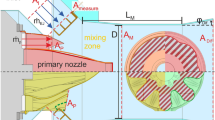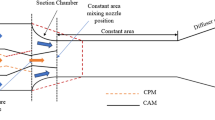Abstract
The ejector system is a useful device for creating high altitude conditions for ground tests of supersonic engines. The ejector performance can be immediately changed by varying the ejector operational mode. The ejector nozzle pressure ratio is well known to have a significant effect of the operational mode of an ejector. However, the effects of the mixing duct length and other geometric design parameters on the ejector mode change have not been clearly determined. In this study, the effects of ejector component geometries and inflow conditions on ejector operational mode are investigated by numerical analysis. By changing the inflow conditions and geometric parameters, twelve test cases are studied. Using the numerical test results, the flow pattern and suction pressure performance of the ejector with a fixed secondary mass flow rate are compared. In the numerical test results, a high primary nozzle stagnation pressure induces a highly underexpanded flow, resulting in the critical operational mode. For the critical operational mode, the mixing duct must be sufficiently long to accommodate the shock train and the choking zone. Primary nozzles with wide angles also induce widely expanded nozzle flows and result in the critical operational mode.
Similar content being viewed by others
Abbreviations
- A* :
-
Aerodynamic throat area for the secondary flow
- Dh :
-
Hydraulic diameter of the mixing duct
- Lm :
-
Mixing duct length
- ṁ p :
-
Mass flow rate of the primary flow
- ṁ s :
-
Mass flow rate of the secondary flow
- P0p :
-
Stagnation pressure of the primary flow
- P0s :
-
Stagnation pressure of the secondary flow
- Pb :
-
Back pressure of the ejector
- R:
-
Gas constant
- T0s :
-
Stagnation temperature of the secondary flow
- γ:
-
Specific heat ratio
- θn :
-
Primary nozzle angle
References
B. M. Tashtoush, M. A. Al-Nimr and M. A. Khasawneh, A comprehensive review of ejector design, performance, and applications, Applied Energy, 240 (2019) 138–172.
H. Wu, Z. Liu, B. Han and Y. Li, Numerical investigation of the influences of mixing chamber geometries on steam ejector performance, Desalination, 353 (2014) 15–20.
A. Hakkaki-Fard, Z. Aidon and M. Ouzzane, A computational methodology for ejector design and performance maximisation, Energy Conversion and Management, 105 (2015) 1291–1302.
J. Smolka, Z. Bulinski, A. Fic, A. Nowak, K. Banasiak and A. Hafner, A computational model of a transcritical R744 ejector based on a homogenous real fluid approach, Applied Mathematical Modelling, 37(3) (2013) 1208–1224.
J. Valle, J. Sierra-Pallares, P. G. Carrascal and F. C. Ruiz, An experimental and computational study of the flow pattern in a refrigerant ejector-Validation of turbulence models and real-gas effects, Applied Thermal Engineering, 89 (2015) 795–811.
A. L. Addy and W. L. Chow, On the starting characteristics of supersonic ejector systems, Journal of Basic Engineering, Trans ASME, 86(4) (1964) 861–868.
F. Li, R. Li, X. Li and Q. Tian, Experimental investigation on a R134a ejector refrigeration system under overall modes, Applied Thermal Engineering, 137 (2018) 784–791.
W. Chen, M. Liu, D. Chong, J. Yan, A. B. Little and Y. Bartosiewicz, A 1D model to predict ejector performance at critical and sub-critical operational regimes, International Journal of Refrigeration, 36 (2013) 1750–1761.
F. Li, Q. Tian, C. Wu, X. Wang and J. Lee, Ejector performance prediction at critical and subcritical operational modes, Applied Thermal Engineering, 115 (2017) 444–454.
O. Lamberts, P. Chatelain and Y. Bartosiewicz, Numerical and experimental evidence of the Fabri-choking in a supersonic ejector, International Journal of Heat and Fluid Flow, 69 (2018) 194–209.
Y. Zhu and P. Jiang, Experimental and numerical investigation of the effect of shock wave characteristics on the ejector performance, International Journal of Refrigeration, 40 (2014) 31–42.
F. Mazzelli, A. B. Little, S. Garimella and Y. Barosiewicz, Computational and experimental analysis of supersonic air ejector: Turbulence modeling and assessment of 3D effects, International Journal of Heat and Fluid Flow, 56 (2015) 305–316.
A. B. Little and S. Garimella, Shadowgraph visualization of condensing R134a flow through ejectors, International Journal of Refrigeration, 68 (2016) 118–129.
Y. J. Lee, S. H. Kang, S. S. Yang and S. J. Kwon, Starting characteristics of the hypersonic wind tunnel with the Mach number variation, Journal of Mechanical Science and Technolog, 28(6) (2014) 2197–2204.
D. J. Deturris, Fabri choking in a two-dimensional reacting flow mixer-ejector, AIAA Paper 2010–384 (2010).
J. C. Dutton and B. F. Carroll, Optimal supersonic ejector design, Journal of Fluids Engineering, 108 (1986) 415–420.
J. C. Dutton, C. D. Mikkelsen and A. L. Addy, A theoretical and experimental investigation of the constant area, supersonic-supersonic ejector, AIAA Journal, 20(10) (1982) 1392–1400.
S. M. V. Rao and G. Jagadeesh, Novel supersonic nozzles for mixing enhancement in supersonic, Applied Thermal Engineering, 71 (2014) 62–71.
N. Wen, L. Wang, J. Yan, X. Li, Z. Liu, S. Li and G. Zou, Effects of operating conditions and cooling loads on two-stage ejector performances, Applied Thermal Engineering, 150 (2019) 770–780.
T. Kanda, Y. Ogawa, D. Sugimori and M. Kojima, Conceptual design model of high-altitude test stand for rocket engines, Trans. Japan Soc. Aero. Space Sci., 59 (2016) 161–169.
Author information
Authors and Affiliations
Corresponding author
Additional information
Recommended by Associate Editor Joon Ahn
Sang Hun Kang received a Ph.D. from KAIST, Korea in 2004. He is currently an Associate Professor of Aerospace System Engineering Department, Sejong University, Korea. Prior to joining the faculty at Sejong University, he was a Senior Researcher at KARI. His research interests are in the area of ramjet engine, scramjet engine, combined cycle rocket engine, liquid rocket engine, turbulent combustion and radiation.
Rights and permissions
About this article
Cite this article
Kang, S.H., Kim, J.G. & Namkoung, HJ. Effects of component geometries and inflow conditions on ejector operational mode. J Mech Sci Technol 33, 5003–5008 (2019). https://doi.org/10.1007/s12206-019-0747-6
Received:
Revised:
Accepted:
Published:
Issue Date:
DOI: https://doi.org/10.1007/s12206-019-0747-6




